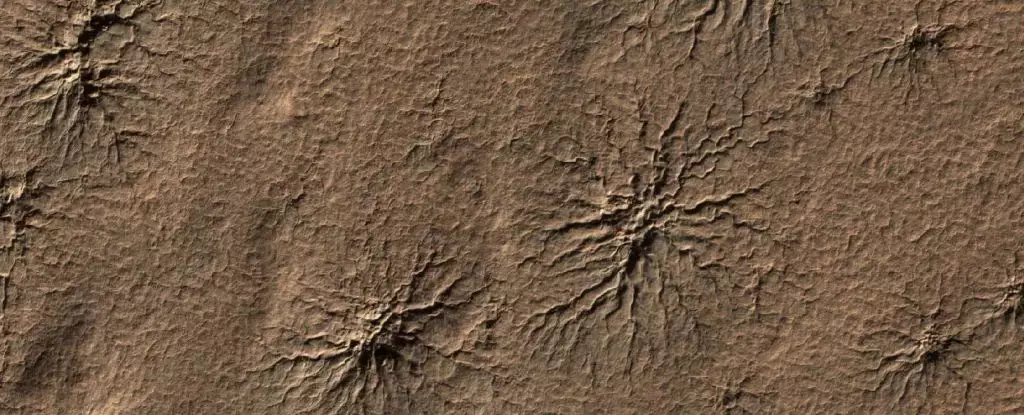Mars, the enigmatic fourth planet from the Sun, continues to captivate scientists and enthusiasts alike with its peculiar geological features. Among the most intriguing phenomena detected on its surface are the so-called “spiders,” captivating patterns that resemble arachnids, scuttling across the planet’s dusty terrains. But these spiders are not living organisms—they are natural formations, termed araneiforms, which emerge in the southern polar regions of Mars each spring, adding to the planet’s mystique. Recent breakthroughs in laboratory simulations have shed light on the formation mechanisms of these geological wonders, deepening our understanding of Martian landscapes.
The Enigmatic Nature of Araneiforms
The araneiforms of Mars are strikingly unique and differ markedly from terrestrial features. Created from seasonal shifts in temperature and atmospheric conditions, these formations can only be seen during Martian spring. Their distinctive long-legged shapes are formed by a complex interplay of frozen carbon dioxide, sublimation, and the Martian regolith. The beauty of these araneiforms lies in their apparent strangeness—they present anOtherworldly iscus together with the wonders of geology. As planetary scientist Lauren McKeown from NASA’s Jet Propulsion Laboratory notes, these features are both curious and aesthetically compelling, demanding explanation and deeper study from scientists passionate about Martian exploration.
The mechanism behind the formation of araneiforms has puzzled researchers for years. One of the most widely accepted explanations is the Kieffer model, proposed by geophysicist Hugh Kieffer. According to this model, during Martian winters, atmospheric carbon dioxide condenses and freezes on the planet’s surface. Come spring, warmer temperatures induce sublimation, which transforms solid carbon dioxide directly back into its gaseous state. This process creates a buildup of pressure beneath the ice layer, which can lead to explosive ruptures, releasing gas and accompanying regolith material, resulting in the formation of spider-like patterns.
However, understanding this process has proven complex—as scientists could not easily observe the phenomena in situ. Hence, a new approach was necessary to confirm the mechanisms proposed in the Kieffer model. Through intricate laboratory experiments, scientists sought to recreate Mars’s environmental conditions to better understand how these fascinating formations develop.
The breakthrough came through a sophisticated apparatus known as the Dirty Under-vacuum Simulation Testbed for Icy Environments (DUSTIE). This chamber mimics the temperature and atmospheric pressure found on Mars, allowing researchers to conduct experiments that shed light on the formation of araneiforms. By utilizing a simulant of Martian regolith—carefully designed to resemble the mineralogical composition of Martian dirt—scientists were able to cool the material, introducing liquid nitrogen to ensure a realistic recreation of Martian winters.
Once the conditions were set, carbon dioxide was introduced into the chamber, where it froze onto the simulated Martian surface. The true breakthrough occurred when researchers incrementally warmed the chamber, producing unexpected eruptions that mimicked the explosive behavior observed on Mars. To their surprise, the breakthrough did not occur on the surface as initially hypothesized; instead, the ice formed within the dirt layer, leading to explosive results that created the long-traced patterns observed in satellite imagery.
Implications for Future Research
The findings have significant implications beyond the mere study of araneiforms. By validating and refining the Kieffer model, researchers have gained valuable insights into other seasonal geological phenomena present on Mars. This improved understanding may provide crucial data for future missions and exploration efforts aimed at unraveling the mysteries of the red planet.
As the scientific community continues to analyze these Martian formations and their properties, the hope is to adapt experimental conditions in the lab to investigate related geological features further. While the idea of “alien spiders” may seem far-fetched, the importance of understanding geological processes on Mars could feed into broader discussions about the planet’s history and its potential for harboring life.
The journey to uncovering the mysteries of Mars is ongoing. With advancements in technology and experimental frameworks, scientists are equipped to draw connections between terrestrial and extraterrestrial geologies, much like the shadows of these spiders that dance across the Martian surface. Though we may not be at risk of an invasion of extraterrestrial arachnids, the exploration of Mars continues to yield wonders that promise to transform our understanding of the universe.


Leave a Reply